Abstract
Educating is an action of using knowledge to assist students to address their real-world personal needs, generating unique personal skills and values. Digital images, as images that consist of picture elements, have become important resources for sustaining education. A cause of concern is that academics use such images to drive learning for sustainability. The intention is to motivate students thereby, thus enhancing their education. In the process, students must comprehend their unique internal intelligence. As such, this study explores the academics’ usage of digital images to educate curriculum studies students at a university in South Africa. Ten academics were purposively and conveniently sampled for this study. Online reflective activities, focus-group discussions, observations, and semi-structured interviews were used for data collection. A pragmatic paradigm with participatory action research, content analysis, and a natural identity framework were used to frame this study. The findings reveal that academics were able to educate students to understand both large and small pictures of the digital images. The large and small pictures represented performance-based and competence-based curricula. However, it was difficult for the students to apply or link what they experienced by way of the digital images to their curriculum studies and real-world problems until the participatory action research was extended from Phase One to Phase Two. Consequently, this study suggests that the reflection stage of participatory action research is the dominant stage of the education process. Reflection supports students in their quest for understanding their internal intelligence, thus naturally addressing their personal, societal, and professional needs.
1. Introduction
It has been a challenge for academics to educate students on mastering the content of their courses in order to apply it to their real-life situations. The challenge arises in that academics and students believe that what they experience always represents objective reality [1]. In mathematics curriculum studies, it is believed that performance-based (vertical) and competence-based (horizontal) curricula are the two dominating curricula that produce objective reality [2,3]. According to Khoza and Fomunyam [4], vertical and horizontal curricula only attempt to address professional and social needs, respectively. The two curricula compromise individual unique internal intelligence that allows humans to address personal needs and to understand their natural/objective reality [5,6].
A natural/objective reality drives human actions from conception to the stage where they are influenced by societies and/or professionals at approximately four/five years old [7]. Before this competence-based (horizontal) and/or performance-based (vertical) curriculum-driven influence, humans act naturally according to their internal intelligence or objective realities. Humans are led to believe that societal and/or professional actions represent their objective realities; yet, these are simply user interfaces [5]. These competence-based (horizontal) and/or performance-based (vertical) curriculum-driven actions are not capable of helping either academics or students to produce identical best performance of their objective realities. As such, a curriculum is needed that produces objective reality when enacted by academics to educate students so that each student can achieve one hundred per cent in all courses.
Digital images that consist of picture elements have become important resources in producing user interfaces that control objective reality through sustaining education [6,8]. Working with the user interfaces that control objective realities may be a solution allowing academics and students to understand their objective realities. This study is in quest of the missing curriculum that produces objective realities. Such a quest has prompted the exploring and understanding of academics’ usage of digital images in educating curriculum studies students. This study explores and understands the academics’ usage of digital images to educate curriculum studies students at a university in South Africa. This study attempts to address the following research questions:
- Which digital images do academics use to educate curriculum studies students?
- How do academics use digital images to educate curriculum studies students?
- Why do academics use digital images in particular ways?
Driven by these research questions, the next sections present a literature review, a theoretical framework, a research design with methodology, findings with discussions, and a conclusion with implications and references.
2. Literature Review
A curriculum is defined as a plan for educating if vertically driven (prescribed document–content-driven or performance-based) and as a plan of educating if horizontally driven (experienced–outcomes-driven or competence-based) [8,9]. On the one hand, a vertical curriculum (performance-based) is content-driven. Content to be mastered by students is strictly prescribed, giving relevant teaching objectives, resources, and a summative assessment [10,11]. Although Goetze [12] believes that a vertical curriculum overloads students with content, denying them the opportunity of applying the mastered content to their objective realities, it is believed to be the one that helps academics and students achieve high performance.
Nevertheless, even if students do not achieve one hundred per cent, a vertical curriculum is said to produce high marks and good performance or achievement. This suggests that a vertical curriculum helps academics and students to produce user interfaces for their survival that are closer to their objective realities. Higher education institutions (HEIs) normally prescribe learning management systems (LMSs) to support students in mastering their course-prescribed content [13,14]. If educating is about achieving high marks or performance and addressing professional needs, a vertical curriculum seems to be more effective than a horizontal curriculum.
On the other hand, a horizontal curriculum is outcomes-driven [15]. Here there are outcomes to be achieved through activities facilitated by academics [16,17]. A horizontal curriculum is effective when the purpose of educating is to promote societal skills that address societal needs. Social media sites (SMSs) have increasingly been used for this curriculum, which promotes socialisation and interaction between people [18,19].
However, none of the two curricula has helped academics to educate students so that each of the students achieves one hundred per cent (100%). This suggests that neither of the two curricula represents objective realities of the students. Students should be given opportunities of reflecting on their experiences in order to understand their unique individual internal intelligence that would enable them to pass their courses with 100%. An individual internal intelligence (human mind) reflects through human actions [6,20]. When students understand their unique intelligences, they become satisfied with educational actions and outcomes. During COVID-19 revolution, some of the factors that increased student satisfaction were social presence (outcomes-driven) in digitalised curriculum (DC), student–academic interaction (content-driven), and student/academic awareness of DC usage [21]. Student satisfaction develops within the individual human mind based on individual level of experience [22].
A human mind is divided into the unconscious, subconscious, and conscious. “The body’s unconscious mind controls all bodily functions such as breathing, digestion, heartbeat, and others through its deoxyribonucleic acid (DNA). The subconscious mind is a permanent memory which stores every experience since inception (beliefs, emotions, feelings, habits, superstitions and others reside here). The conscious mind is the reasoning, thinking, intellectual human activity which processes certain pieces of information at a time” [23]. The subconscious mind stores whatever is experienced in the form of items to be used in interpreting digital images (objects) for such educating [24].
Digital images are believed to be a resource which helps students to reflect on their experiences using their minds. In this way, students find and understand their personal identities that represent their individual unique internal intelligence linked to their objective realities [1,6]. Education combines both the teaching and learning minds that assist people to realise their objective realities [7]. The human mind can be either in the unconscious, the subconscious, or the conscious state. In the unconscious state, the body remains responsible for all its functions, such as breathing, blinking, digestion, movement, and others [25]. The subconscious mind holds the permanent memory that stores every experienced action [26]. The conscious mind is the seat of the human reasoning process, allowing people to distinguish between real and imaginary actions [27].
Consequently, educating becomes the use of the conscious mind to interrogate the subconscious and unconscious minds in producing new actions. Digital images in education become important resources that trigger relevant stored actions in the subconscious mind, assimilating and/or accommodating new actions [23,28]. Digital images assist humans to trigger what they have in their subconscious and/or unconscious minds in order to be used by the conscious mind in reasoning and becoming aware of their objective realities [24,29]. Objects of digital images represent what humans experience through their senses as their real-life objective realities, to be analysed for human development [30]. A better way of understanding one’s objective reality is by analysing the ambiguity of digital images. “Analysis is the process of separating a whole into its constituent parts to gain a better understanding of it” [31]. Therefore, when one is able to analyse digital images as representations of both large and small pictures/figures, one is able to apply the same analysis in understanding one’s real-life objective reality [1,29].
The Framing of the Study
A study conducted by Khoza [32] on teachers’ identities portrayed professional, societal, and personal identities as the conceptual framework for human objective realities or natural identity (Figure 1). Digital images assist humans to reflect on their professional, societal, and/or personal needs which enables them to teach and/or learn.
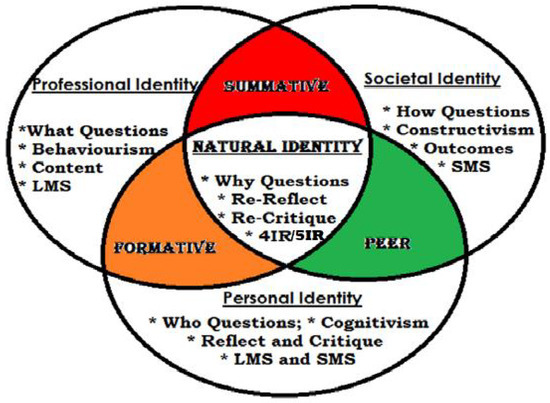
Figure 1.
Natural identity framework (NIF) adapted from Khoza [23].
Professional identity addresses one’s professional or disciplinary needs through prescribed structures having strict rules to be followed [33]. The “what” questions such as what content, objectives, resources, assessment, and others drive the teaching actions in order to follow strictly prescribed structures. It is believed that professional prescribed structures should be strictly followed so as to produce intended actual actions or behaviours [23]. LMSs are examples of structures used by HEIs.
Societal identity addresses one’s social needs. Such needs are based on one’s societal or community needs—with the focus on outcomes. The “how” question asks, for instance, how learning is facilitated. Everyday knowledge is used to construct content; groups are established which drive learning in order to celebrate positive outcomes or to comfort those producing negative outcomes. Education results in constructing knowledge through various resources such as SMSs and others. This process also indirectly prescribes resources and/or activities because they come from the facilitators, not the students. Although societal identity is believed to be student-centred, one may not agree with this notion if the resources/activities are still prescribed by the facilitators according to their own needs.
However, personal identity may take the form of student- or academic-centredness because it addresses the “who” questions such as who needs the action of teaching and learning, inter alia. Personal identity focuses on the beliefs or philosophies that underpin the actions and their outcomes [6,32,34]. Educational actions are driven by specific situations. The individual needs are being addressed [35]. Although the educational actions and outcomes reflect underpinning beliefs, they may only represent the user interface, not objective realities (natural identity) [5,36].
Natural identity addresses the “why” questions, in which individual actions, outcomes, and beliefs are naturally driven. For example, a few seconds after a baby/child is born, the baby is able unconsciously to breathe, blink, digest, and excrete, amongst other bodily functioning, sans training by professionals or societies. This suggests an important natural internal individual intelligence that works well without needing external identities (professional and societal). By the time a child reaches the age of five, a conscious mind has developed that assists the subconscious to distinguish between what is real and what is imaginary [7]. The unconscious mind is already playing a great role in the developing body. This study is set in a conceptual framework (NIF) found within a pragmatic paradigm and beyond.
3. Research Design and Methodology
A pragmatic paradigm was used in this study because it allows both qualitative and quantitative processes [37,38]. The pragmatic paradigm relies on the interrogation of human experiences through their actions and/or outcomes. By these means, individual unique needs required in individual situations are addressed. Pragmatists believe that individuals have their unique internal intelligence that helps them to respond naturally to what the universe throws at them in order to develop their unique identities. All individuals have their unique definition of objective reality, researchers choosing the most appropriate methods to be used [39,40].
By means of purposive with convenience sampling, this study selected the ten most accessible of fourteen academics who used digital images to educate curriculum studies students. The other four academics were not available to participate. Pseudonyms were used in upholding the principles (anonymity, confidentiality, voluntariness of participants, and others) of ethical clearance. The study uses the letter “P” and numerals to represent the participants. These range from Participant 1 (P1) to Participant 10 (P10).
The pragmatic paradigm uses the research style known as participatory action research (PAR) (Figure 2) for operational purposes [41]. The PAR emphasises participation and action as continuous in action research. “The object of action research is that there should be no research without action, no action without research” [42]. Hence, PAR involves a much more practical form of research that seeks to provide an opportunity for liberation of the oppressed. PAR strives towards comprehending the world through attempting to transform it by liberating the oppressed in order to understand their needs and identities [43].
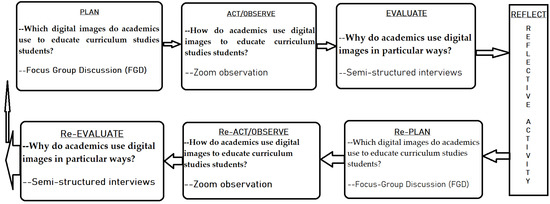
Figure 2.
Two phases of participatory action research (PAR).
The PAR stages were used to frame the methodology for this study. These stages were employed to guide image-reflective activities, Zoom observation, focus-group discussions (FGD), and semi-structured interview data-generation methods effected in both phases of the PAR. McDonald [44] asserts that PAR is a research methodology in which participants and researchers are actively engaged in making informed decisions which generate practical knowledge to improve their professional, societal, and personal lives. Morales [45] adds that PAR merges action and reflection in participants together with others in order to forge practical solutions. This suggests that PAR with its stages (plan, act, observe, evaluate, and reflect) is carried out to make a useful contribution to individuals’ understanding and knowledge and how that knowledge defines their identity, affecting, either positively and/or negatively, their practice. For this study, Stage One (plan and re-plan) addressed Research Question One in both Phase One and Phase Two through FGDs. Stage Two (act/observe and re-act/observe) addressed Research Question Two in both Phase One and Phase Two through Zoom observation. Stage Three (evaluate and re-evaluate) addressed Research Question Three in both Phase One and Phase Two through semi-structured interviews. Stage Four (reflect) addressed all the research questions through reflective activities by concluding Phase One and introducing Phase Two.
The purpose of this study was to explore and understand academics’ use of digital images in educating curriculum studies students to understand their identities through interaction with images. PAR proved fitting and was conducted in two phases. Data generated in Phase One were used in Phase Two to support the transformation process of the participants.
The content analysis method was used for data analysis in this study to combine themes generated from the NIF with other themes generated from the data [32]. The content analysis is a process of interrogating text and images in order to gain better understanding of one’s identity through such text and images [31]. The participants searched for unambiguous images on the internet and used them for educating curriculum studies students. Of the images used, this study selected ten to generate the findings. The ten selected images were most accessible from the internet (https://za.pinterest.com/imatter2him777/ambiguous-images/and were accessed on 14 March 2022) through the Google search engine.
Four principles of trustworthiness were taken into consideration to ensure dependability (consistency through the use of direct quotations), transferability (applicability of the study to various contexts), confirmability (elimination of bias through triangulation), and credibility (truth value, including having the participants authenticate the findings) [23].
4. Findings and Discussions
The findings of the first five images (Figure 3, Figure 4, Figure 5, Figure 6 and Figure 7) used for Phase One of the PAR challenged the students—students either saw the objects or the faces of people. According to the participants, objects such as vases and small pictures within larger pictures represented a performance-based curriculum driven by the professional identity of the NIF. Larger pictures or faces represented a competence-based curriculum driven by societal identity. Identifying both (objects and people) represented a pragmatic curriculum driven by personal identity. The images were interpreted as follows:
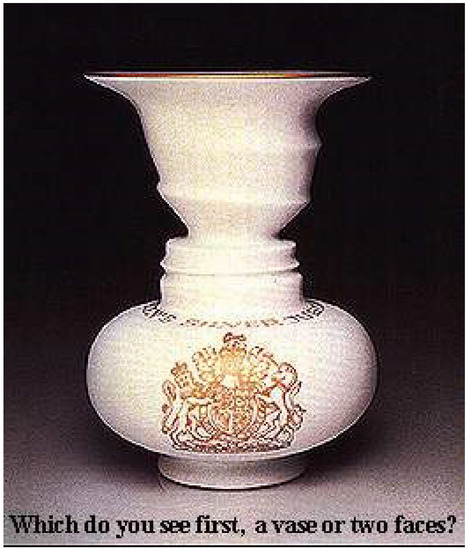
Figure 3.
Faces or vase.
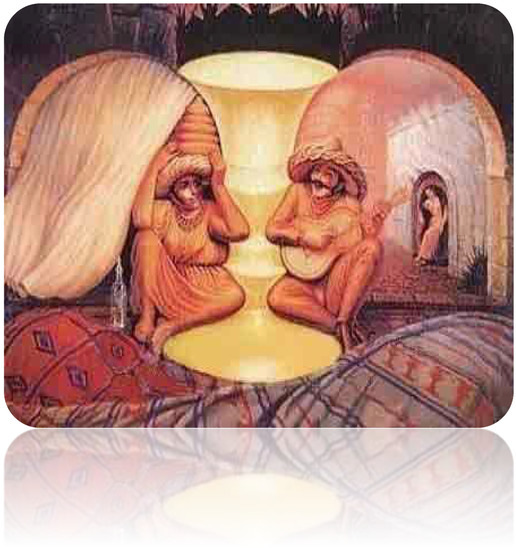
Figure 4.
Faces/people, vase, and tower.
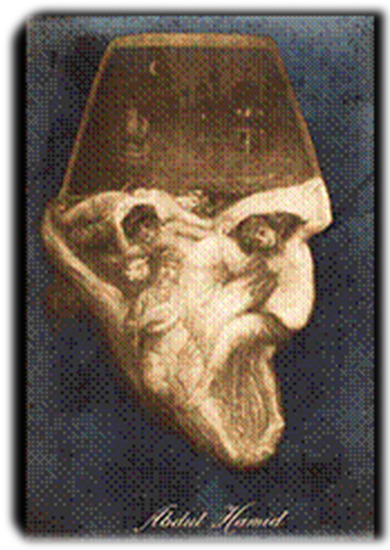
Figure 5.
An old man wearing a fez.
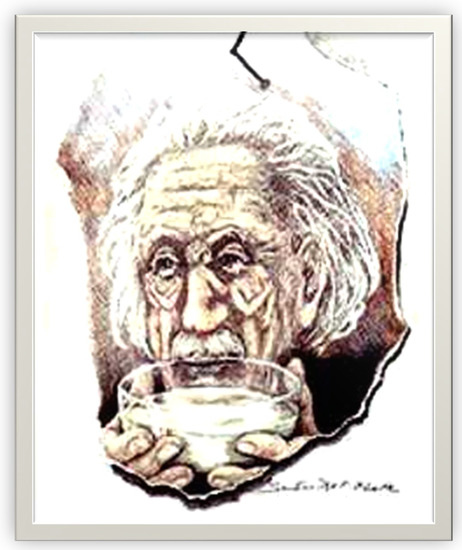
Figure 6.
Faces/people and container of liquid (bowl of water).
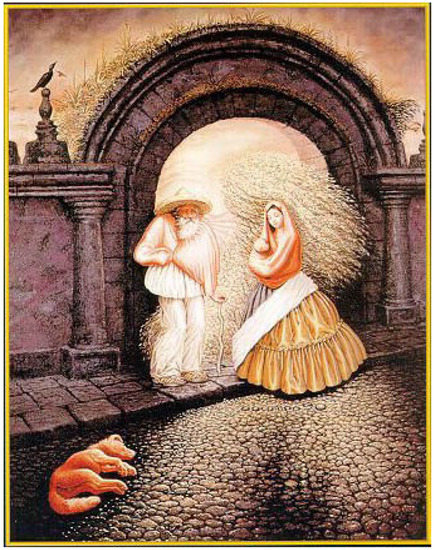
Figure 7.
Faces/people, arch, pillars, bird, and dog.
The aim in displaying the image in Figure 3 was to show the students two dark faces as silhouettes and a vase displaying a coat of arms. According to the participants and Zoom observation, some students saw two faces while others saw the vase with a logo. “It took other students a lot of explanation in trying to show them the two faces” (P2 supported by other participants). “Moving from images to explain that humans unlike animals use duality interpretation of what they come across. For example, if they have big, they will have small; good they will have bad…” (P1, supported by others).
The findings reveal that a duality of interpretation distracts students from focusing on one issue in order to perfect the interpretation or action. Focusing on one prescribed content, issue, or action suggests that the participants promoted a performance-based curriculum which is driven by professional identity [32]. A performance-based curriculum which, according to the participants, represented small pictures of the digital images, is believed to be closer to the students’ objective realities: students achieve high marks when they master their course content [11,13,46]. However, this is as yet only a belief because there is no conclusive evidence that the application of a performance-based curriculum produces students who always achieve 100% in their courses as their objective realities. The students sometimes merely pass with distinctions, pass with average marks or fail their courses, as evidence that they have not achieved a curriculum for their objective realities. What students achieve is the advancement of their professions through mastering the content of their courses so that when the courses are offered next time academics add new challenging tasks [10,47]. It seems important to view both the larger and smaller pictures as taxonomies.
The image in Figure 4 is in the form of two large depictions of an old woman and an old man facing each other. On the faces of the old woman and man, there are smaller images of a seated woman holding an object on her head and a man playing the guitar, respectively. A woman is also depicted on the ear of the larger man. A drawing of a vase separates the two larger images. The woman in the larger image wears an earring in the shape of a small tower with a person atop. “Students interpreted this one better than the first one because they started to see the smaller pictures more than the bigger pictures… Our students started to understand the world in terms of duality actions produced by performance-based and competence-based curricula as per our aim of using digital images to facilitate such an understanding…” (P7, supported by others).
The findings suggest that a duality interpretation may not be as distracting as it was in the previous image, because objective realities may be represented as either smaller or larger pictures [5,24,28]. Other students do pass their courses in the same way as those who apply a performance-based curriculum even if they apply a competence-based curriculum. It would seem that students’ needs determine the direction in which individuals should go in order to move towards achieving 100% in their courses. There are situations that need a more performance-based curriculum than those requiring a competence-based curriculum and vice versa [2,3].
Figure 5 used the name Abdul Hamid to influence students to look at the larger picture of an old man. However, “most students identify pictures of three women on the face of the old man as the smaller pictures…” (P4, supported by others).
This account suggests that one’s subconscious mind can be trained to follow a new direction of moving from larger to smaller pictures or vice versa. Although students’ subconscious minds can be trained to store issues arising from a performance-based curriculum in the same way as issues arising from a competence-based curriculum, they still need a tool or user interface that can give them their objective realities of achieving 100%. Digital images are able to trigger what humans were naturally born with (unique internal intelligence) to be used as resources or user interfaces that assist them to control objective realities for their survival, even if the objective is unknown [1,5]. For example, some students do achieve 100% in their courses, but they do not have resources for sustaining the achieving of 100% as their objective realities. Subconsciously, humans have unique resources that manage them, known as the technology of self, ideological-ware, or technology of education [27,48,49]. However, even these human resources have not managed to produce a curriculum that brings about objective realities.
Figure 6 shows a large image of an old man drinking something; three small figures are depicted on the face of the old man. “The majority of students were able to see the smaller pictures before they see the old man. It became very easy for the students to see smaller pictures than bigger pictures…” (P9, supported by others).
Academics were thus able to create a transformative educating environment that helped students to use their internal unique intelligences (ideological-ware) to manage their objective realities for their survival, based on smaller and larger pictures. In other words, the students were able to understand their personal identities that produced a pragmatic curriculum [36,50]. A pragmatic curriculum is driven by human needs that are understood through self-reflection and critique [51,52]. A pragmatic curriculum tends to be closer to individual objective reality if the aim of educating is to understand individual unique identities, thereby addressing personal needs [16,53]. However, a pragmatic curriculum has not helped students also to sustain the management of their objective realities even through the use of digital images [5,24].
Figure 7 shows a bust of an old man under an archway; pillars stand either side of the old man. Above the pillar on the left, there is a carving with a bird atop it. The man’s hand can also depict a reclining dog. An old man is standing on the face of the old man. On the man’s ear is reflected a woman carrying her baby. To the left and right of the carving are four faces. Two look towards each other, and one looks to the front but merged with the face to the left of the carving. A less obvious face is seen to the right of the bird. Above the pillar on the right, a fifth face looks to the right. “Our students were able to identify all the pictures because they were trained by the observation of the previous pictures…” (P8, supported by others).
Identifying the pictures in the image as intended suggests that students were both consciously and subconsciously aware of the analysis process which assists individuals to use digital images to understand their professional, social, and personal identities [13,31]. In the remaining images, students were able to identify both the smaller and larger pictures. Students were analytically fluent especially in Phase Two where they even remembered the pictures of Figures 11 and 12.
Figure 8 shows a rose (la rose) surrounded by a frame, the pillars in the background as the larger picture. In the heart of the rose, a couple is embracing. This demonstrates the French meaning of the caption: La vie en rose (life in the pink; life when in love). There are also small images of stockings and shoes to the left of the flower. “The majority of students saw the kissing couple and later saw the other pictures…” (P5, supported by others).

Figure 8.
Rose, legs, couple, and shoes.
The findings show that students mastered the analysis in the previous images and found it easier to interpret the remaining images.
Figure 9 shows a couple viewing a stretch of water within a larger image of an infant. “The majority of students saw the baby and later the couple by the ocean…” (P1, supported by others).

Figure 9.
Baby reclining and/or couple viewing stretch of water.
The findings show that students had mastered the analysis in the previous images and found it easier to interpret the remaining images.
Figure 10 shows a tree as the larger picture with ten hidden faces around the tree. “The majority of students identified faces before they spoke about what seemed like the tree…” (P3, supported by others).
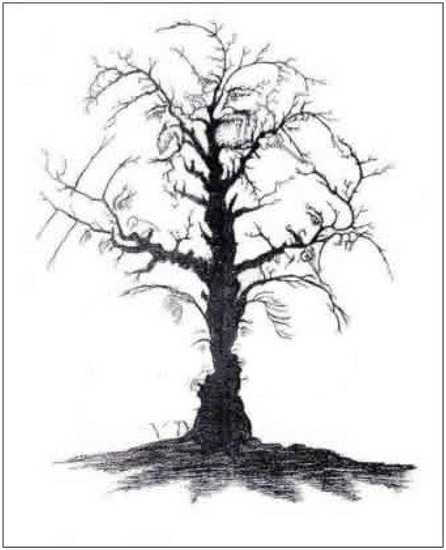
Figure 10.
Ten faces.
The findings show that students had mastered the analysis in the previous images and found it easier to interpret the remaining images.
Figure 11 shows a horse’s head and neck. However, “our students identified it as a frog on a pond … We had to draw lines on the horse to show the students and they later saw the horse…” (P10, supported by others).
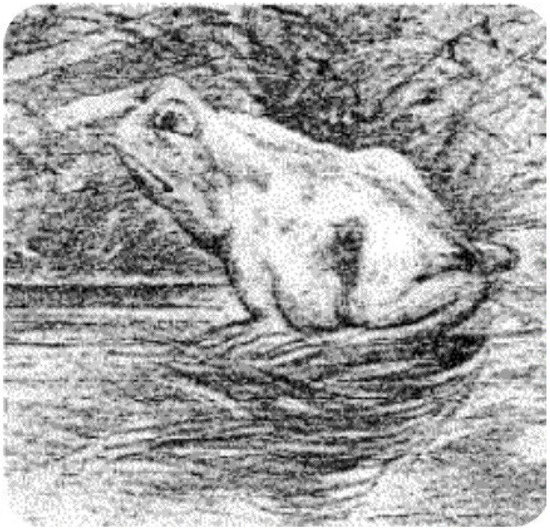
Figure 11.
Horse’s head and neck.
The findings show that students had mastered the analysis in the previous images because the images are faces of people. When people were replaced by animals, students were unable to interpret the images correctly. When students expected to see a horse, they did not pay attention sufficiently to see the horse; students saw the frog in the Phase One of the PAR. These findings support those of a study conducted by Mast and Kosslyn [24] on “visual mental images can be ambiguous: insights from individual differences in spatial transformation abilities” which discovered that students have challenges when images are rotated. Effective educating and transformation involve reflections, translation, rotation, enlargement, and reduction [24,36]. The participants applied reflections as part of the data generation for the study, enlargement, and reduction. A reflection uses the conscious mind to interrogate the subconscious mind in order to improve resources of both the subconscious and unconscious mind (driven by pragmatic issues) [27,54]. Enlargement is a cognitive process of interpreting digital images based on large pictures (driven by competence-based). Reduction is a cognitive process of interpreting digital images based on smaller pictures (driven by performance-based) [36]. What seemed to be missing in the last two images, especially in Figure 12, were translation and rotation.
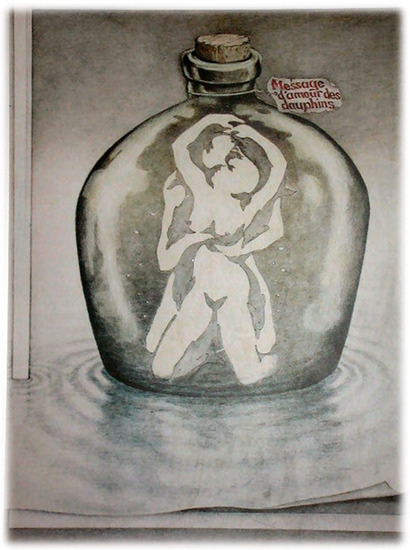
Figure 12.
Dolphins (fish) in the white spaces of a bottle.
Figure 12 shows approximately ten dolphins in the white spaces between the embracing couple etched on a bottle. “Our students only saw a naked couple etched on a bottle… We had to train them to see the dolphins/fishes…” (P6 supported by others). “It was clear that the students were looking for faces or people because the first images had faces or people that seemed to be hidden from some of the students…” (P2, supported by others).
The findings reveal the missing translation and rotation as two of the important ingredients of effective educating and transforming. Translation is a cognitive process of interpreting images by approaching from different directions, projecting various forms of light (bright, dim, dark, etc.) onto the image to be interpreted [55]. In other words, using bright light may produce different images from those seen by dim light, or interpreting an image from above may be different from interpreting it from below. Rotation is a cognitive process of interpreting images depicting movement [56]. For example, an image may be better understood when it changes its original direction (Figure 11) or space (Figure 12). This suggests that the usage of digital images in educating requires application of reflection, translation, rotation, enlargement, and reduction in order to help staff and students find and understand their identities. However, according to Khoza [23], these processes have proved insufficient without human re-reflection and re-critiquing processes that produce natural or objective realities. In other words, people should have ongoing self-reflection and critique in order to come closer to their objective realities. The participants continued to reflect and critique their actions even as part of the PAR in order to understand their natural identities or objective realities, as indicated in the discussions below (next section).
5. Reflective Discussions on the Findings
The following reflections on the findings were generated by the participants from their students, based on Phase Two of the participatory action research (PAR):
“They learned from these images to internally keep what they interpreted as negative thoughts generated by any picture or what they experienced within them so that it could not be externally known by other people who may remind them about these thoughts even after they have forgotten about them. Negative thoughts generated by certain images, theories/curriculum approaches prevent them from infinite life possibilities of growing their ability to properly manage their life activities because they cause fears… For example, when they looked at the image with the dolphins they only saw a naked couple and most of them did not talk because they thought that their eyes were telling the truth about the naked couple. They only talked after I helped them to see the dolphins. Since it is difficult if not impossible to think out negative thoughts, they learned to overcome them (naked couple) by telling people about their internal positive thoughts (dolphins) so that they became their life style when people keep on reminding them… They strived to understand pragmatic curriculum as their life style because it combines the strengths of performance-based and competence-based curricula…”(P1, supported by P4, 5, 8, and 10)
The above accounts suggest that these participants and their students were aware of their subconscious minds, in which all thoughts reside and are retrieved when required for action [23]. Awareness supported the students in knowing/understanding their curriculum identities, based on what they intended to promote as positive thoughts over what they perceived as negative thoughts. In other words, students were aware of their internal or inner identities triggered by the digital images.
“Through the digital images, our students learned to be aware of their inner being in order to protect it when they help others. If it is not protected, it may be commercialised for transitions that may lead to stress, depression, blowback or burnout and unable to touch human life as their mission… Their understanding of pragmatic curriculum through images helped them to align their actions with relevant needs…”(P8, supported by P1, 2, 6, and 9)
This reveals the importance of becoming aware of one’s personal identity before one supports others. One may then assist others, based on one’s strengths. One’s weaknesses are concealed from those we help: one’s strengths encourage others to generate positive thoughts about themselves, positively responding to the universe [57]. As much as they concentrate on the development of their personal and natural identities through positive thoughts, people wish to transform those around them when understanding activities from the universe. In supporting others who want to become aware of the power of their internal intelligence, the inner being or personal (natural) identities should not be sold to others for money. Equally, one should not help others expecting them to return the favour, because this leads to human suffering. When individuals are aware of their natural identities, such individuals live happier lives than when they have others around in their private spaces. They are able to concentrate on the process of nurturing their internal intelligence [32].
“The digital images helped the students to understand that the universe throws various activities to us in order to internally respond through our internal intelligence (pragmatic and/or natural actions). All the activities are happening within us… humans have control over them when they are consciously aware of them in order to positively interpret them to produce actions… One has to be internally aware of the self before helping others to be aware of their inner being to avoid stress from their inability of interpreting world activities used for survival…” (P4, supported by P5, 6, 7, and 9). This reveals that human suffering (stress, depression, burnout, etc.) is caused by an inability to use the conscious mind to guide the subconscious mind in responding to what the universe offers people [54,58]. When the conscious mind interrogates the subconscious and unconscious actions, people become aware of their unique individual internal intelligence based on their deoxyribonucleic acid (DNA) [23].
“Our students learned to reclaim or to go back to their original identity which they were created/born with before it was claimed by social and professional spaces. We all have important intelligence within us that help us to address all our needs. During COVID-19 lockdowns, it was the same intelligence that helped us to continue with our lives and decide whether to vaccinate or not…”(P3, supported by P4, 7, 9, and 10)
It is thus essential to become aware of the individual human intelligence which drives individuals from conception. During the COVID-19 revolution, some people who were COVID-19-positive survived through their internal intelligence or DNA without even taking vaccines. This suggests the importance of dealing with sources of activities more than merely symptoms of the activities. The majority of humans have suffered during the COVID-19 revolution for believing in treating symptoms over and above studying the natural/original sources of activities. A pragmatic curriculum has helped higher education institutions to design their own processes to be used in completing their 2020 and 2021 academic years or calendar [50].
“…through the digital images that promoted a pragmatic curriculum awareness, our students learned not to wait for suffering before they improve the way they think. For example, HEIs should have used mandatory online learning long before COVID-19 because it was clear during COVID-19 that they could afford it… This affected the students because they were not formally trained for the online learning…” (P9, supported by P3, 5, 7, and 8). This suggests that human internal intelligence can improve, whether humans are facing challenging situations (suffering) or whether they are happy. COVID-19 demanded that HEIs use online learning or a digitalised curriculum (DC) to save the 2020/2021 academic year/calendar. This demonstrated to HEIs that they could afford relevant DC resources such as digital images that bring realities into their classrooms or living rooms.
“Our students became aware that reality is internally and uniquely experienced because it does not exist outside our thoughts. Through digital images the students also learned to continue to search for the internal intelligence that helps them with the ever-changing human identities…” (P7, supported by P2, 3, 5, and 6). Therefore, since reality is internally constructed through individual intelligence, people should become more aware of their natural identities or objective realities, thus becoming relevant in light of the ever-changing demands of the universe. This leads to important educational implications.
6. Conclusions and Implications
Based on the findings of this study, digital images to facilitate student self-reflection assisted students in finding and understanding their unique personal and natural identities. The participants were able to educate their students to understand the larger and smaller life images. These can be combined by one’s unique internal intelligence thus moving closer to one’s objective reality (natural identity). In trying to identify and understand their personal strengths and needs, the participants, together with their students, became aware of the performance-based, competence-based, and/or pragmatic curricula as the main forms of curriculum.
A performance-based curriculum is a content-driven curriculum that demands the perfection of the actual actions. Actions should be guided by strict rules or prescribed content to be mastered by students. Actions of summative assessment assess the absence of what was not cognitively achieved by students. This curriculum type promotes a one-size-fits-all system in order to produce equality in educating. As a result, the definition of quality educating is the students’ mastering of prescribed content and their producing of high marks for performance through strict academic instructions. The rationale for educating is to address professional needs, producing and prescribing new structures. Achievement of educating objectives is found when students achieve learning outcomes that drive a mostly competence-based curriculum.
A competence-based curriculum is driven by learning outcomes which in turn promote equity. The assumption is that students should be supported according to their needs which are decided on by their communities. As a result, the definition of quality educating is the students’ achievement of learning outcomes based on the skills required by students’ communities. Academics facilitate the achievement of learning outcomes. The rationale for educating is to address community/societal needs and to be ready to use the structures/resources produced by professionals. For example, professionals produced Zoom or Microsoft teams for conferencing/meetings. Educational institutions use these technologies for educating without reflecting on their objective realities. Only the founders (Eric Yuan, Bill Gates, etc.) of these resources are aware of the objective realities (circuits and language used to produce them). Individual unique internal intelligences of students may not be given a space when resources have been produced if they do not reflect societal needs.
A pragmatic curriculum is driven by individual unique needs based on one’s intelligence. In this way, one comes closer to one’s objective reality because one is motivated to reflect and critique one’s experiences as the foundation for education. The pragmatic curriculum prioritises the internal unique intelligence (ideological-ware) behind the actions (prescribed content) and their consequences (learning outcomes). However, these forms of curriculum have not yet produced students’ or academics’ natural identities/objective realities that assist them to gain 100% in all their courses even if they re-reflect and re-critique [4]. There should therefore be more studies conducted which would help both students and academics find and understand their objective reality or natural identities to be used in educating so as to produce 100% in their actions every time.
Funding
This research received no external funding.
Institutional Review Board Statement
Protocol reference number: 00014074 has been granted by the University of KwaZulu-Natal Ethics Committee.
Informed Consent Statement
Participants signed Informed Consent Letters for their participation and allowing the author to publish this article.
Data Availability Statement
Available from the author on request.
Conflicts of Interest
The author declares no conflict of interest.
References
- Fields, C.; Hoffman, D.D.; Prakash, C.; Singh, M. Conscious agent networks: Formal analysis and application to cognition. Cogn. Syst. Res. 2018, 47, 186–213. [Google Scholar] [CrossRef]
- Bernstein, B. Vertical and Horizontal Discourse: An essay. Br. J. Sociol. Educ. 1999, 20, 157–173. [Google Scholar] [CrossRef]
- Hordern, J. Bernstein’s sociology of knowledge and education(al) studies. In Knowledge and the Study of Education: An International Exploration; Furlong, G.W.J., Ed.; Symposium Books: Providence, RI, USA, 2017; pp. 191–210. [Google Scholar]
- Khoza, S.B.; Fomunyam, K.G. (Eds.) Can Alignment of Digital Resources with Needs Produce a New Curriculum Theory for Teaching? In Curriculum Theory, Curriculum Theorising, and the Theoriser: The African Theorising Perspective; Brill: Leiden, The Netherlands, 2020; pp. 219–236. [Google Scholar]
- Prakash, C.; Stephens, K.D.; Hoffman, D.D.; Singh, M.; Fields, C. Fitness Beats Truth in the Evolution of Perception. Acta Biotheor. 2021, 69, 319–341. [Google Scholar] [CrossRef] [PubMed]
- Morgan, D.L. Pragmatism as a Paradigm for Social Research. Qual. Inq. 2014, 20, 1045–1053. [Google Scholar] [CrossRef]
- Battro, A.M. The teaching brain. Mind Brain Educ. 2010, 4, 28–33. [Google Scholar] [CrossRef]
- Kornhaber, R.; Betihavas, V.; Baber, R.J. Ethical implications of digital images for teaching and learning purposes: An integrative review. J. Multidiscip. Healthc. 2015, 8, 299–305. [Google Scholar] [CrossRef]
- Khoza, S.B. Lecturers’ Reflections on Curricular Spider Web Concepts Transformation Strategies. In Transformation of Higher Education Institutions in Post-Apartheid South Africa; Ivala, E.N., Scott, C.L., Eds.; Routledge: London, UK, 2019; pp. 15–26. [Google Scholar]
- Tyler, R.W. Basic Principles of Curriculum and Instruction; University of Chicago Press: Chicago, IL, USA, 2013. [Google Scholar]
- Makumane, M.A. Theory of Enactment Strategies as a Way forward in Enacting a French Integrated Curriculum in Lesotho. In Curriculum Theory, Curriculum Theorising, and the Theoriser; Fomunyam, K.G., Khoza, S.B., Eds.; Brill: Leiden, The Netherlands, 2021; pp. 295–319. [Google Scholar]
- Goetze, M. Five Reasons Why CAPS is Harming Our Children. Available online: https://www.linkedin.com/pulse/five-reasons-why-caps-harming-our-children-marina-goetze (accessed on 13 March 2022).
- Sokhulu, L.H. Students’ experiences of using digital technologies to address their personal research needs during the COVID-19 lockdown. Afr. Identities 2021, 19, 436–452. [Google Scholar] [CrossRef]
- Zheng, H.; Branch, R.M.; Lee, H. Creating Animated Videos as an Innovative Instructional Alternative to Writing Essays for Presenting Research. TechTrends 2019, 63, 533–542. [Google Scholar] [CrossRef]
- Le Grange, L. Contemporary curriculum theories and their influence on teaching and learning. In Education Studies: For Initial Teacher Development; Ramrathan, L., le Grange, L., Higgs, P., Eds.; Juta & Company (Pty), Ltd.: Cape Town, South Africa, 2017; pp. 112–124. [Google Scholar]
- Mabuza, D.H.; Khoza, S.B. The ‘What’, ‘How’, and ‘Why’ of Classroom Groupings: Educators’ Reflections. J. Educ. Stud. 2021, 20, 151–170. [Google Scholar]
- Shoba, M.E.; Khoza, S.B. Professionalising Socialisation for Pragmatic e-Curriculum to the Rescue of South African Universities. In Multimodal Learning Environments in Southern Africa: Embracing Digital Pedagogies; Olivier, J., Oojorah, A., Udhin, W., Eds.; Palgrave Macmillan: Cham, Switzerland, 2022; pp. 119–140. [Google Scholar]
- Mpungose, C.B.; Khoza, S.B. Students’ Reflections on the Use of Zoom Video Conferencing Technology for Online Learning at a South African University. Int. J. Afr. High. Educ. 2021, 8, 159–178. [Google Scholar] [CrossRef]
- Czerniewicz, L.; Agherdien, N.; Badenhorst, J.; Belluigi, D.; Chambers, T.; Chili, M.; de Villiers, M.; Felix, A.; Gachago, D.; Gokhale, C.; et al. A Wake-Up Call: Equity, Inequality and COVID-19 Emergency Remote Teaching and Learning. Postdigital Sci. Educ. 2020, 2, 946–967. [Google Scholar] [CrossRef]
- Ramsøy, T.Z.; Michael, N.; Michael, I. A Consumer Neuroscience Study of Conscious and Subconscious Destination Preference. Sci. Rep. 2019, 9, 15102. [Google Scholar] [CrossRef] [PubMed]
- Mohammed, L.A.; Aljaberi, M.A.; Amidi, A.; Abdulsalam, R.; Lin, C.-Y.; Hamat, R.A.; Abdallah, A.M. Exploring Factors Affecting Graduate Students’ Satisfaction toward E-Learning in the Era of the COVID-19 Crisis. Eur. J. Investig. Health Psychol. Educ. 2022, 12, 1121–1142. [Google Scholar] [CrossRef] [PubMed]
- Khoza, S.B. Master of Education Students’ Reflections: Which Curriculum Reasons Are Promoted or Limited by Skype Resources? Progress. S. Afr. J. Open Distance Learn. Pract. 2017, 39, 1–19. [Google Scholar] [CrossRef] [PubMed]
- Khoza, S.B. Exploring the Migration to a Digitalised Curriculum at UKZN. Educ. Sci. 2021, 11, 682. [Google Scholar] [CrossRef]
- Mast, F.W.; Kosslyn, S.M. Visual mental images can be ambiguous: Insights from individual differences in spatial transformation abilities. Cognition 2002, 86, 57–70. [Google Scholar] [CrossRef]
- Bargh, J.A.; Morsella, E. The unconscious mind. Perspect. Psychol. Sci. 2008, 3, 73–79. [Google Scholar] [CrossRef]
- Rezaee, M.; Farahian, M. Subconscious vs. unconscious learning: A short review of the terms. Am. J. Psychol. Behav. Sci. 2015, 2, 98–100. [Google Scholar]
- Khoza, S.B.; Biyela, A.T. Decolonising technological pedagogical content knowledge of first year mathematics students. Educ. Inf. Technol. 2020, 25, 2665–2679. [Google Scholar] [CrossRef]
- Leung, B.C.; Williams, M.; Horton, C.; Cosker, T.D. Modernising anatomy teaching: Which resources do students rely on? J. Med. Educ. Curric. Dev. 2020, 7, 1–7. [Google Scholar] [CrossRef]
- Choudhury, S.; Nagel, S.K.; Slaby, J. Critical Neuroscience: Linking Neuroscience and Society through Critical Practice. Biosocieties 2009, 4, 61–77. [Google Scholar] [CrossRef]
- Daelli, V.; van Rijsbergen, N.J.; Treves, A. How recent experience affects the perception of ambiguous objects. Brain Res. 2010, 1322, 81–91. [Google Scholar] [CrossRef] [PubMed]
- Postic, G.; Ghouzam, Y.; Chebrek, R.; Gelly, J.-C. An ambiguity principle for assigning protein structural domains. Sci. Adv. 2017, 3, e1600552. [Google Scholar] [CrossRef]
- Khoza, S.B. Can Teachers’ Identities Come to the Rescue in the Fourth Industrial Revolution? Technol. Knowl. Learn. 2021, 26, 1–22. [Google Scholar] [CrossRef]
- Makumane, M.A. Students’ perceptions on the use of LMS at a Lesotho university amidst the COVID-19 pandemic. Afr. Identities 2021, 2021, 1–18. [Google Scholar] [CrossRef]
- Kaushik, V.; Walsh, C.A. Pragmatism as a Research Paradigm and Its Implications for Social Work Research. Soc. Sci. 2019, 8, 255. [Google Scholar] [CrossRef]
- Dewey, J. Logic: The Theory of Inquiry; Henry Holt: New York, NY, USA, 1938. [Google Scholar]
- Khoza, S.B.; Mpungose, C.B. Digitalised Curriculum to the rescue of a Higher Education Institution. Afr. Identities 2022, 20, 1–21. [Google Scholar]
- Creswell, J.W.; Creswell, J.D. Research Design: Qulitative, Quantitative, and Mixed Methods Approaches; SAGE Publications, Inc.: London, UK, 2018. [Google Scholar]
- Kivunja, C.; Kuyini, A.B. Understanding and Applying Research Paradigms in Educational Contexts. Int. J. High. Educ. 2017, 6, 26–41. [Google Scholar] [CrossRef]
- Cohen, L.; Manion, C.; Morrison, K. Research Methods in Education; Routledge: London, UK, 2018. [Google Scholar]
- Morgan, D.L. Integrating Qualitative and Quantitative Methods: A Pragmatic Approach; SAGE: Thousand Oaks, CA, USA, 2014. [Google Scholar]
- McNiff, J. Action Research—Principles and Practices; Routledge: London, UK, 2013. [Google Scholar]
- Rauch, F.; Schuster, A.; Stern, T.; Pribila, M.; Townsend, A. Promoting Change through Action Research: International Case Studies in Education, Social Work, Health Care and Community Development. In Promoting Change through Action Research; Brill: Leiden, The Netherlands, 2014. [Google Scholar]
- Esau, O. Emancipatory action research. In Education Studies: For Initial Teacher Development; Ramrathan, L., le Grange, L., Higgs, P., Eds.; Juta & Company (Pty), Ltd.: Cape Town, South Africa, 2017; pp. 444–455. [Google Scholar]
- McDonald, C.D. Understanding participatory action research: A qualitative research methodology option. Can. J. Action Res. 2012, 13, 34–50. [Google Scholar] [CrossRef]
- Morales, M.P.E. Participatory Action Research (PAR) cum Action Research (AR) in Teacher Professional Development: A Literature Review. Int. J. Res. Educ. Sci. 2016, 2, 156–165. [Google Scholar] [CrossRef]
- Branch, R.M. Reducing Sepsis Prevalence in Acute-Care Hospitals: System Design and Usability Barriers IT Professionals Need to Overcome; Colorado Technical University: Colorado Springs, CO, USA, 2020. [Google Scholar]
- Shoba, M.E. Theorising teachers’ experiences of teaching reading in the African context. In Curriculum Theory, Curriculum Theorising, and the Theoriser: The African Theorising Perspective; Fomunyam, G.K., Khoza, S.B., Eds.; Brill: Leiden, The Netherlands, 2021; pp. 237–255. [Google Scholar]
- Foucault, M. Security, Territory, Population: Lectures at the Collége de France 1977–1978; Picador: New York, NY, USA, 2007. [Google Scholar]
- Percival, F.; Ellington, H. A Handbook of Educational Technology, 2nd ed.; Kogen Page: London, UK, 1988. [Google Scholar]
- Govender, R.G.; Khoza, S.B. First-hand user experience: Can Kaltura video come to the rescue of Moodle during/post COVID-19? Afr. Identities 2022, 21, 1–20. [Google Scholar] [CrossRef]
- Grange, L.L.; Du Preez, P.; Ramrathan, L.; Blignaut, S. Decolonising the university curriculum or decolonial-washing? A multiple case study. J. Educ. Univ. KwaZulu-Natal 2020, 80, 25–48. [Google Scholar] [CrossRef]
- Waghid, Y. Qualty, Dissonance and Rhythm within Higher Education. S. Afr. J. High. Educ. 2019, 33, 1–7. [Google Scholar]
- Pithouse-Morgan, K.; Samaras, A.P. Polyvocal Professional Learning through Self-Study Research; Sense Publishers: Boston, MA, USA, 2015; Volume 18. [Google Scholar]
- Mpungose, C.B.; Khoza, S.B. Postgraduate Students’ Experiences on the Use of Moodle and Canvas Learning Management System. Technol. Knowl. Learn. 2020, 27, 1–16. [Google Scholar] [CrossRef]
- Kitson, A. Knowledge translation and guidelines: A transfer, translation or transformation process? Int. J. Evid.-Based Healthc. 2009, 7, 124–139. [Google Scholar] [CrossRef] [PubMed]
- AlDahdouh, A.A. Jumping from one resource to another: How do students navigate learning networks? Int. J. Educ. Technol. High. Educ. 2018, 15, 1–17. [Google Scholar] [CrossRef]
- Chopra, D. What Is Wholeness? The Consciousness View. Glob. Adv. Health Med. 2021, 10, 21649561211043794. [Google Scholar] [CrossRef] [PubMed]
- Grandpierre, A.; Chopra, D.; Doraiswamy, M.P.; Tanzi, R.; Kafatos, M.C. A Multidisciplinary Approach to Mind and Consciousness. NeuroQuantology 2013, 11, 607–617. [Google Scholar] [CrossRef][Green Version]
Publisher’s Note: MDPI stays neutral with regard to jurisdictional claims in published maps and institutional affiliations. |
© 2022 by the author. Licensee MDPI, Basel, Switzerland. This article is an open access article distributed under the terms and conditions of the Creative Commons Attribution (CC BY) license (https://creativecommons.org/licenses/by/4.0/).